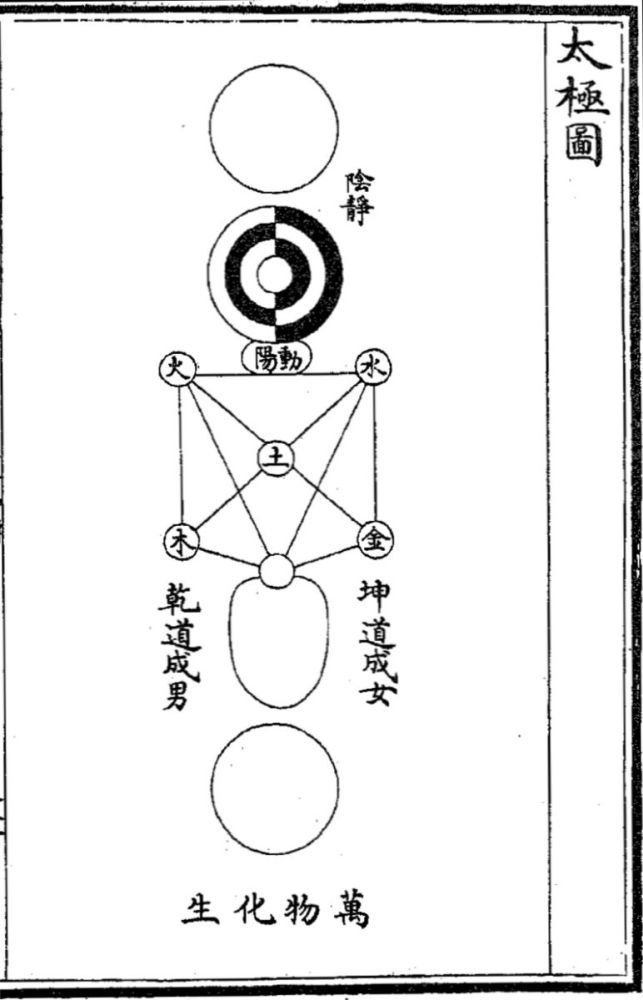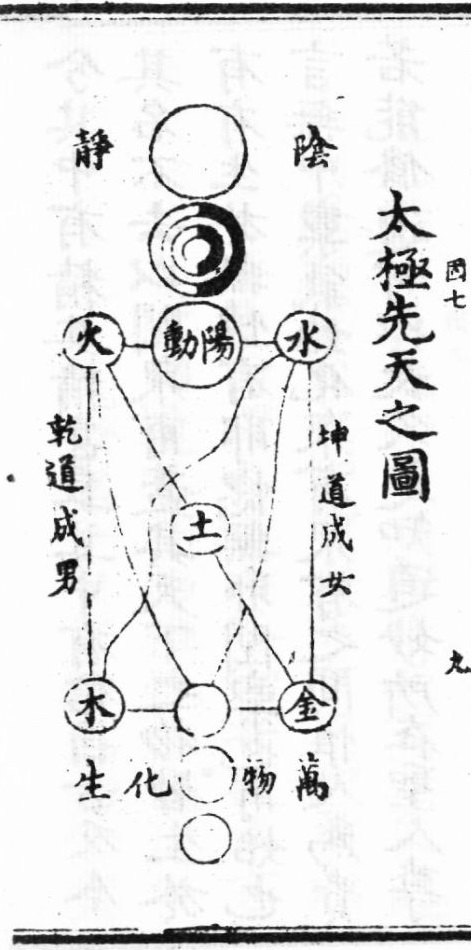Taiji tushuo 太極圖說 "Explanation of the diagram of the Utmost Extreme" is a brief text on Neo-Confucian cosmology written by Zhou Dunyi 周敦頤 (1017-1073). The idea is derived from an image of the "non-dimension" (wujitu 無極圖) or the "anterior Heaven" (xiantiantu 先天圖) created by the Daoist master Chen Tuan 陳摶 which came upon Zhou Dunyi via the teachings of Zhong Fang 種放 (955-1015) and Mu Xiu 穆修 (979-1032). Huang Zongyan 黃宗炎 (1616-1686) was of the opinion that the Taijitu had been invented by Master Heshang 河上公 (1st cent. CE), who is famous for his commentary on the Daodejing 道德經. From that source, the image was transmitted by Chen Tunan 陳圖南, who used it to describe skills of inner alchemy (xiulian 修煉). Zhu Xi 朱熹 (1130-1200) held that the text was often appended to Zhou's book Tongshu 通書, with the result that many readers believed the Taiji tushuo was the last chapter of this book.
The text of the Taiji tushuo explains that the non-dimension and the Utmost Extreme were the original states of the cosmos in which movement (dong 動) and standstill (jing 靜) of matter were effected according to the influence of the two "energies" or potentials (liang yi 兩儀) Yin and Yang 陰陽. With the change from Yin to Yang, shapeless substance came under the control of the Five Agents (wuxing 五行) water, fire, wood, metal, and earth, whereupon the ten thousand objects and beings (wanwu 萬物) found their shape. Those in which Yang or the force of the hexagram (see Yijing 易經) Qian 乾 prevailed were males, while a dominance of the Yin hexagram Kun 坤 produced females. These shapes were subject to constant movement and transformation. "Non-dimension" means that all matter existed as an idea, but without a shape. Shape was only created by the transformation from the status of non-dimension to "extreme dimension" (taiji).
The most intelligent and flexible (zui ling 最靈) beings were humans. For humans, an archetypical "human extreme" (renji 人極) was existent in the origins of the cosmos in which the Confucian virtues of keeping to the golden mean (zhong 中), uprightness (zheng 正), kindness (ren 仁) and righteousness (yi 義) were prepared, as well as the potential to return to primordial quiescence (jing), which meant in practice abstention from improper desires (wuyu 無欲).
The text combines the Daoist belief in the Taiji with Confucian concepts of change as seen in the Classic Yijing "Book of Changes". The original title of the text was therefore Taijitu yishuo 太極圖易說 "An explanation of the image of the Utmost Extreme by use of the Changes". It was one of the first Neo-Confucian texts of the Northern Song period 北宋 (960-1126) and had great influence on the cosmology of this philosophical trend.
 |
 |
The blank circle at the top symbolizes Yin and quiescence (yin jing 陰靜), and the mixed black-white circle set in the second position Yang and movement (yang dong 陽動). The crossed lines represent the interaction of the Five Agents water, fire, wood, metal, and earth. Influence of the Hexagram Qian produced male things (qian dao cheng nan 乾道成男), and that of the hexagram Kun female ones (kun dao cheng nü 坤道成女). The lowest circle(s) stand for the ten thousand beings that have come into existence (wanwu hua sheng 萬物化生). Left: According to Zhu Zhen 朱震, Hanshang Yizhuan 漢上易傳, appendix Guatu 卦圖 (Qinzaotang Siku quanshu huiyao 摛藻堂四庫全書薈要 edition). Right: According to Shangfang dadong zhenyuan miaojing tu 上方大洞真元妙經圖 in Zhengtong daozang 正統道藏 (Dongxuan bu 洞玄部, Lingtu lei 靈圖類). |
|
The text is preserved in three versions, namely Zhu Xi's paragraph-and-sentence commentary Taiji tushuo zhangju 太極圖說章句 (also called Taiji tushuo jie 太極圖說解), the biographical collection Song-Yuan xue'an 宋元學案, and a (lost) original chart mentioned by Zhu Zhen 朱震 (d. 1138). Zhu Xi even changed the original, for instance, the first sentence, from "out of the non-dimension, the Utmost Wxtreme emerges" (zi zuji er wei taiji 自無極而為太極), to "the non-dimension is also the utmost extreme" (wuji er taiji 無極而太極).
The imperial series Siku quanshu 四庫全書 includes Cao Duan's 曹端 (1376-1434) commentary Taiji tushuo shuije 太極圖說述解. Another important edition is Wang Jianchang's 王建常 (1615-1701) commentary collection Taiji tushuo jijie 太極圖說集解. Studies were written by Huang Zongyan (Taijitu bian 太極圖辨) and Mao Qiling 毛奇齡 (1623-1716, Taiji tushuo yiyi 太極圖說遺義). The text is found in Zhou Dunyi's collected writings Zhouzi quanshu 周子全書.